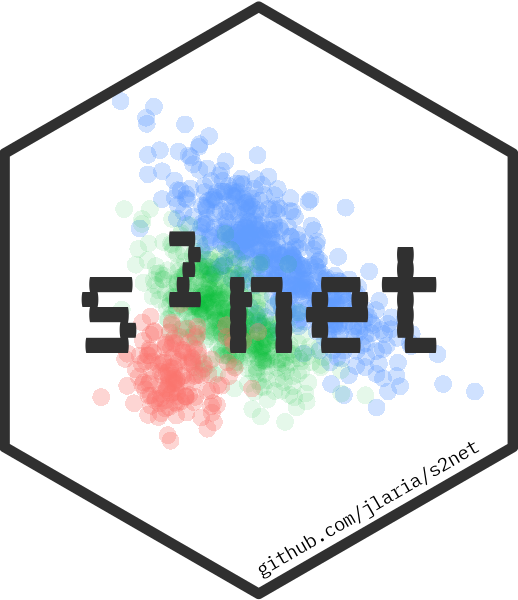

R package s2net
s2net
in R, written in C++ using
RcppArmadillo and integrated into R via
Rcpp modules.You can install the released version of s2net from CRAN with:
install.packages("s2net")The development version can be installed with:
devtools::install_github("jlaria/s2net", build_vignettes = TRUE)This is a basic example which shows you how to use the package. Detailed examples can be found in the documentation and vignettes.
library(s2net)
# Auto-MPG dataset is included for benchmark
data("auto_mpg")Semi-supervised data is made of a labeled dataset xL,
the labels yL, and unlabeled data xU. Package
s2net includes the function s2Data to process
semi-supervised datasets.
head(auto_mpg$P2$xL, 2) # labeled data
#> displacement horsepower weight acceleration year origin
#> 15 113 91 2372 15.0 70 3
#> 19 97 84 2130 14.5 70 3
head(auto_mpg$P2$yL, 2) # labels
#> [1] 24 27
head(auto_mpg$P2$xU, 2) # unlabeled data
#> displacement horsepower weight acceleration year origin
#> 1 307 17 3504 12.0 70 1
#> 2 350 35 3693 11.5 70 1
train = s2Data(auto_mpg$P2$xL, auto_mpg$P2$yL, auto_mpg$P2$xU, preprocess = TRUE)
head(train$xL, 2)
#> displacement horsepower weight acceleration year origin2
#> 15 0.1788500 1.0544632 0.1799762 -0.6392182 -1.878311 -0.6575667
#> 19 -0.5510247 0.7397884 -0.5209896 -0.8471591 -1.878311 -0.6575667
#> origin3
#> 15 1.356622
#> 19 1.356622The data is centered and scaled, and factor variables are automatically converted to numerical dummies. Constant columns are also removed. If we wanted to use validation/test data, we must pre-process it according to the training data, with:
valid = s2Data(auto_mpg$P2$xU, auto_mpg$P2$yU, preprocess = train)There are two ways to fit a semi-supervised elastic-net using
s2net. The easiest way is using the function
s2netR, that returns an object of S3 class
s2netR.
model = s2netR(train, params = s2Params(lambda1 = 0.01, lambda2 = 0.01, gamma1 = 0.01, gamma2 = 100, gamma3 = 0.1))
class(model)
#> [1] "s2netR"
model$beta
#> [,1]
#> [1,] -0.28152012
#> [2,] 0.04116177
#> [3,] -3.02848437
#> [4,] 0.61602553
#> [5,] 3.65674054
#> [6,] 0.71547766
#> [7,] 0.43169913
ypred = predict(model, valid$xL)If we are fitting the semi-supervised elastic-net many times, using
the same train data (for example, searching for the best
hyperparameters), then it is faster to use the C++ class
s2net instead.
obj = new(s2net, train, 0) # 0 = linear
# We fit the model with
obj$fit(s2Params(0.01, 0.01, 0.01, 100, 0.1), 0, 2) # frame = 0 (ExtJT), proj = 2 (auto)
obj$beta
#> [,1]
#> [1,] -0.28700933
#> [2,] 0.04228791
#> [3,] -3.02580178
#> [4,] 0.61559052
#> [5,] 3.65723926
#> [6,] 0.71451133
#> [7,] 0.43040118
ypred = obj$predict(valid$xL, 0) #0=default predictions
# or
ypred = predict(obj, valid$xL)
#> Warning in if (class(newX) == "s2Data") {: the condition has length > 1 and only
#> the first element will be usedMore examples can be found in the package documentation and vignettes.
vignette(package="s2net")